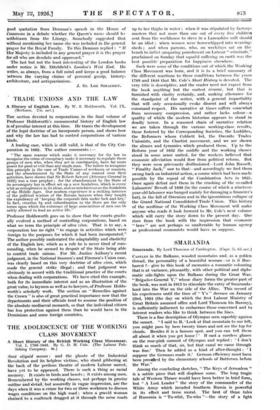THE ADOLESCENCE OF THE WORKING CLASS MOVEMENT
Stint aliquid manes : and the ghosts of the Industrial Revolution and its helpless victims, who stand gibbering at • the back of the perilous theatre of inodein Labour unrest, have yet to be appeased. There is such a thing as racial memory. It exists in birds and beasts ; it exists among men. Remembered by the working classes, not perhaps in precise outline and ‘ietail, but assuredly in vague impression, are the days when it was a crime for two or three workinen to discuss wawa_ conditions on the high road ; when a gravid woman chained to a coaltruck dragged at it through the mine roads up to her thighs in water ; when it was stipulated by factory. masters that not more than one out of every five children sent from the workhouse to slave in a Lancashire mill should be an idiot ; when women were horsewhipped into weaving- sheds ; and when parsons, who, on weekdays sat on the bench to inflict unsparing punishment on Labour " criminals," proclaimed on Sunday that squalid suffering on earth was the best possible' preparation for happiness elsewhere.
Such were some of the conditions out of which the Working Class Movement was born, and it is to a brief summary of the different reactions to these conditions between the years 1789 and 1848 that Mr. Cole's Short History is devoted. The very title is descriptive, and the reader need not expect from the book anything' but the curtest résumé, but that is furnished with clarity certainly, and, making allowance for the standpoint of the writer, with a general impartiality that will only occasionally evoke dissent and will always command respect. His narrative at times suffers somewhat from necessary compression, and rather lacks colour—a quality of which the modern historian appears to stand in deadly terror. In a reasoned chain of narrative relation we are taken through the various working-class revolts, those fostered by the Corresponding Societies, the Luddites, the Reformers whom Cobbett led, the Owenite Trades Unionists, and the Chartist movement, and we are shown the abuses and tyrannies which produced them. Up to the Reform year of 1832 the middle and the working classes stood in some sense united, for the workers believed that economic alleviation would flow from political reform. But they were soon grievously disillusioned—Lord John Russell, " Finality Jack," saw to that—and accordingly we find them swung back on industrial action, a course which had been made possible by the repeal of the Combination Acts in 1825. Once again defeat met them in the crushing of the so-called Labourers' Revolt of 1830 (in the course of which a nineteen- year-old labourer was hanged mainly for damaging a financier's hat), in the fall of Owenism and in the ignominious collapse of the Grand National Consolidated Trade Union. This history of the seedtime of the Working Class Movement will make anyone who reads it look forward to Mr. Cole's next volume which will carry the story down to the present day. One rises from the book with the impression that economic " laws " are not perhaps so unalterable by human agency as professional economists would have us suppose.














































 Previous page
Previous page